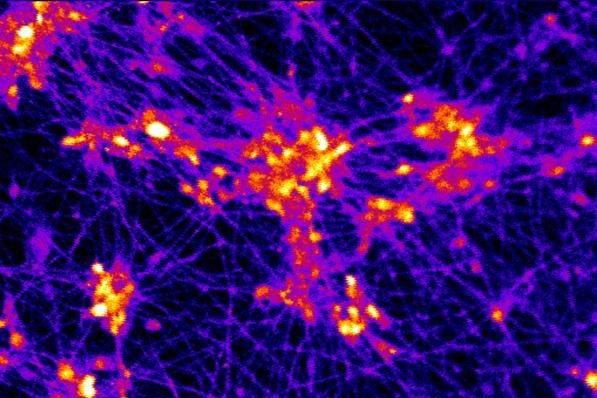Human neurons on a 3D scaffold designed to help the cells form neuronal networks to be injected into patients exhibit firing activity, seen in yellow, in response to electrical current. Photo by Dr. Prabhas Moghe/Rutgers
BETHESDA, Md., March 17 (UPI) -- Scientists developed a scaffold that allows them to grow functional human neurons, which could lead to injections of fresh brain cells as part of treatment for neurodegenerative conditions.
The 3D micro-scaffold developed at Rutgers University and Stanford University allows scientists to turn reprogrammed stem cells into neuronal networks, more of which survived when injected into mouse brains than previous efforts at brain cell replacement.
Individual cells injected into brains don't have a high survival rate, but scientists found that injecting cells that formed neural connections while growing on the scaffold significantly increased the number that survived.
"If you can transplant cells in a way that mimics how these cells are already configured in the brain, then you're one step closer to getting the brain to communicate with the cells that you're now transplanting," Dr. Prabhas Moghe, research director at the School of Engineering and Health Sciences Partnerships at Rutgers University in a press release. "In this work, we've done that by providing cues for neurons to rapidly network in 3D."
For the study, published in Nature Communications, scientists designed a scaffold, made of webbed polymer strands, that is about 100 micrometers wide.
Scientists then seeded the scaffold with pluripotent stem cells created from adult skin cells and induced to differentiate into neural cells. As they grew, the cells produced outgrowths, linking them to one another, allowing them to transmit and receive neural signals.
The tiny neural networks were then injected into slices of mouse brain, as were individual neural cells, with the scientists finding cells in the networks were about 3.5 times more likely to survive than isolated, solo cells. When the scaffolds were injected into the brains of live mice, scientists found the tiny networks increased cell survival by 38 times over isolated cells.
The next step will be fine-tuning the scaffolds and finding ways to differentiate stem cells into specific types of brain cell, with the specific goal of developing a treatment for Parkinson's disease, according to the National Institutes of Health.
Although the method of growing new cells is promising, an actual treatment for Parkinson's or any other condition using the scaffold-grown cells is likely 10 to 20 years away, the scientists said.















